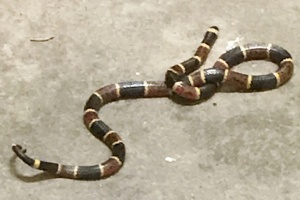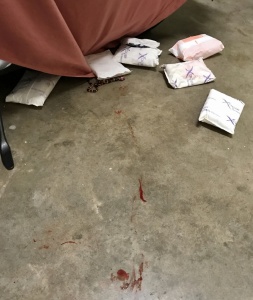It was late, time to close up the house and go to bed.
It was not the time to discover a coral snake in the garage two feet from the cat door.
The cat door that enters the kitchen from the garage.
Nor was it the time to see our young cat hovering over said snake, both pondering a move.
That particular image was not recorded on my phone camera although the phone was in my hand at the time.
As a reporter and photographer, it’s hard to let a spot-news-shot get away, but senses reined in. In a flash, I opened the door, grabbed the kitten, retreated back to the kitchen and secured the cat door.
My phone was in my hand because my husband and I were texting our good nights to each other.
Yes, things happen as soon as he’s called out of town on a job.
A number of things were racing through my head: how to get the snake out of the garage; how to get it contained to transport it; to where would I transport it; would I be swift enough to capture it; and the overarching fact that I was wearing sandals.
I didn’t want the snake to slither into hiding before I could deal with it and any closed-toe-snake-incident shoes were elsewhere in the house. If it advanced toward me, I would totally freak.
But, I wanted a photo. Finally, in a “duh” moment, I took a shot through the door glass so I could text it to Morgan.

During this time, I also was trying to recall the ditty every Texas child learns in grade school about yellow and fellow and Jack. I could not recall it.
In a text with the snake photo, I asked Morgan, “Is this a coral snake?”
He texted back, “Think so, look it up to be sure.”
At this point, the snake hadn’t moved, so I compared my photo with photos on the internet.
I texted back, “Yep, coral snake.”
“It is dangerous to the cats, best kill it,” he texted.
I’d already thought of that, but I was trying to think what was available in the house to use — butcher knife would put my hand too close to the snake and only one other option was coming to mind.
I texted, “Shooting it might cause ricochet and damage your car.”
“Crush its skull with something,” he texted back.
“I have to step over it to get to something.”
Everything handy for that detail was in the garage on the other side of the door, and I was still worried about it slithering over my feet, crawling into Morgan’s motorcycle, getting under the cars, or worse — hiding somewhere.
“If it’s not moving, it is probably injured,” he texted.
Then it moved; it straightened out and looked ready to bolt.
And I had an idea!
I opened the freezer door and armed myself with a couple of those freezable packs to put in coolers to keep drinks cold.
I quickly slipped out the door, raised the icepack over my head and with as much force as I could muster, slammed a frozen pack down onto the snake engaging in a direct hit. It began flopping toward the sheet covering Morgan’s bike; wham, another direct hit.
I texted back, “It was playing possum, but it’s injured now.”
With more packs, I bombarded the snake until I felt the danger had been eliminated.

Sad tale but cats are family. I swept up the snake, put it in the garbage, then cleaned up the blood.
In retrospect, I can’t help but wonder if one of the cats brought the snake into the garage. It was in the spot in front of the door where our other cat periodically presents me with gifts. I don’t think it’s the time of year when snakes are looking for a warm hidey-hole in a building.
Through the whole 15-minute snake incident, I kept thinking about something I’d learned during our Texas Master Naturalist training — that it would be really hard (for a human) to be bitten by a coral snake. First of all, their mouths are really small, their fangs are curved back and you’d have to stick your smallest finger into their mouth in order to be injected by their deadly venom. I was hoping I wasn’t told wrong so I did some research.
First of all, here’s the ditty:
Red and yellow, can kill a fellow;
Red and black, friend of Jack.
According to National Geographic, though their venom is highly toxic, no deaths from coral snake bites have been reported in North America since the late 1960s. Nevertheless, their bites can be extremely painful and lead to cardiac arrest.
Coral snakes’ small, fixed fangs and small mouth mean that it is difficult for them to puncture human skin — let alone leather boots. Humans are mostly bitten when trying to pick up a coral snake.
The snake’s neurotoxic venom causes rapid paralysis and respiratory failure in its prey; however, according to the National Institute of Health, it can take many hours for symptoms to appear in humans.
Additionally, there is often little or no pain or swelling in humans from a coral snake bite. Symptoms include slurred speech, double vision, and muscular paralysis.
Unfortunately, as of 2012, according to Wikipedia, because of the relative rarity of coral snake bites, combined with the high costs of producing and maintaining an antivenom (also called antivenin) supply, antivenom production in the United States (for coral snakes) has ceased. Nor is it cost effective to produce a synthetic antivenom.
Before going to bed, I had checked both cats, looking for puncture wounds or swelling and found none. I didn’t know that they weren’t out of the woods, had they been bitten. Fortunately, the cats are fine.
According to Wagwalking.com, and Petmd.com, in articles about coral snake bites and cats, (also applies for dogs) symptoms may not appear immediately.
It is not unusual for symptoms to start up to 18 hours after the bite (generally the animal’s lip) occurred. The most obvious sign of a problem before symptom onset is the bite mark itself. A coral snake bite appears as two puncture wounds with some blood loss at the wound site. Once symptoms begin to show, they can progress rapidly. The most serious symptom is paralysis, including respiratory paralysis, which can be fatal.
Symptoms Include:
- Weakness
- Breathing trouble
- Drooling
- Altered voice or inability to meow (or bark)
- Difficulty swallowing
- Altered mental state or abnormal behavior
- Diarrhea
- Vomiting
- Seizures or muscle spasms
- Paralysis
- Respiratory failure
Coral snakes are active at night. During the day they like to burrow in the soil, under rocks and habitat debris in dense under story.
